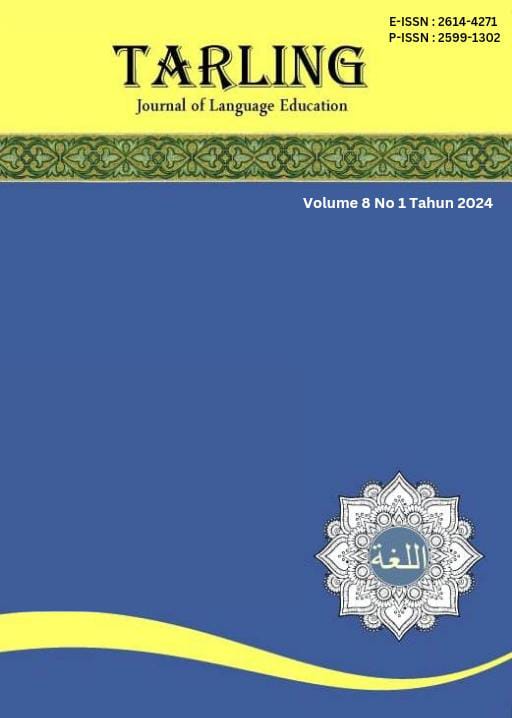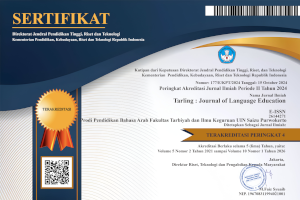Model Kognitif Psikolinguistik Terkini dalam Menunjang Pembelajaran Struktur Bahasa Arab
DOI:
https://doi.org/10.24090/tarling.v8i1.10430Kata Kunci:
Psycholinguistic, Cognitive, structural learning of ArabicAbstrak
Psycholinguistic understanding helps teachers to detail teaching strategies that take into account how students process Arabic information, understand sentence structure, and overcome potential learning difficulties. Cognitive theory emphasizes aspects of understanding, mental processes, and organization in language acquisition. This view states that the stages of students' cognitive development influence their language development. In this research, the effectiveness of the cognitive model in learning Arabic becomes a benchmark in determining whether the teacher's role is fulfilled in applying psycholinguistic tests to students. So that the latest alternative for learning Arabic has emerged based on its new understanding. In this research, the researcher limited it to language structure material or often referred to as nahwu (syntax). Because learning nahwu holds great urgency in developing Arabic language skills. This research uses a qualitative descriptive approach, as well as the use of metasynthesis techniques for SLR (systematic literature review) research. With the systematic literature review method, research will be carried out using systematic, explicit and reproducible steps to synthesize (identify, evaluate, interpret) a number of research works and ideas that have been produced by researchers. The results of this research, in the cognitive aspect, researchers found that structural learning of Arabic (Nahwu) with the TBL (Task Based Learning) and PBL (Problem Based Learning) models is a learning model that can provide significant learning results in improving students' cognitive abilities, because both This model provides stimulus to students. Thus making cognitive abilities develop efficiently and effectively. This makes PBL and TBL alternative options in learning Arabic which is based on psycholinguistic cognitive modelsUnduhan
Diterbitkan
2024-06-09
Terbitan
Bagian
Articles
Lisensi
Hak Cipta (c) 2024 Ahmad Rizki Nugrahawan, Zainal Rafli, Samsi Setiadi

Artikel ini berlisensiCreative Commons Attribution-ShareAlike 4.0 International License.
Authors who publish with this journal agree to the following terms:
- Authors retain copyright and grant the journal right of first publication with the work simultaneously licensed under a Creative Commons Attribution License that allows others to share the work with an acknowledgement of the work's authorship and initial publication in this journal.
- Authors are able to enter into separate, additional contractual arrangements for the non-exclusive distribution of the journal's published version of the work (e.g., post it to an institutional repository or publish it in a book), with an acknowledgement of its initial publication in this journal.
- Authors are permitted and encouraged to post their work online (e.g., in institutional repositories or on their website) prior to and during the submission process, as it can lead to productive exchanges, as well as earlier and greater citation of published work (See The Effect of Open Access).










